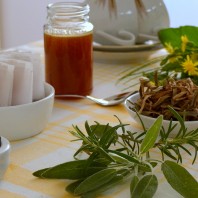Infusion: all abaut it.
Antonietta 17/09/2013It’s obtained by liquid pours over leaves, buds, flowers, fruits, drugs (fresh or dried), rich in flavors and fragrances, to extract the active principles you need; leave it to stand a ranging time from 3 minutes to 8 hours, then use the liquid after filtered, the ingredients are discarded . The infusion is the easiest way to extract the active principles from herbs and plants. However there are two ways to obtain infusion:
- hot liquid infusion,
- cold liquid infusion.
Hot liquid infusion.
Heat the chosen liquid at temperature ranging from 30°C to 90°C, pour it over one or more ingredients, from which you want to extract the active principles. Leave it to stand from 3 min to the time necessary for complete cooling or beyond (its use intended depending). It ‘s the most widely used method, because it’s easy and immediate. It can be obtained by:
- hot water,
- hot oil.
Infusion with hot water.
Heat the water to 95°C, pour over the herbs, cover and leave to stand a ranging time from 3 to 10 minutes (chosen herbs depending); then filter all through a sieve with a mesh narrow then use it for external use, internal use or oral use. This method is quickly to extract the active principles of herbs; all herbs, fresh or dried, used for infusion, which should be consumed within 24 hours.
External use.
- It can be used for bath, sitz bath, foot bath, body wrap: pouring the filtered infusion in hot water.
Internal use.
- Fumigation: it means the use of herbs active principles through the vapors; the infusion is poured into very hot water, inhaling the vapors, which should be hot but not boiling.
- Inhalation: should be carried out with cold or lukewarm infusion.
Oral use.
- The best doses for oral use are 2 or 3 cups of infusion per day, to be taken before, after or between meals, according to prescription. The oral use of active principles extracted from herbs and drugs by infusion, is recommended to relieve small ailments and to benefit from the soothe and revitalize effects.
Infused with hot oil.
It’s obtained pouring 500 ml oil (sunflower oil, olive oil, linseed oil …) in a heat-resistant container and add 250 grams dried herbs or 500 grams fresh herbs, then cooked in a double boiler for about 3 hours over low heat and stirred occasionally. When the time’s up, strain all through cheesecloth or nylon sieve; when all the oil is filtered, close the cloth and squeeze very well with a little wine-press or potato masher, to extract any residual benefit from herbs; pour into dark glass bottles, date and label them. They can be preserved for 1 year.
This method is the best to extract the active principles from herbs with many leaves Chickweed (Stellaria media), Nettle (Urtica dioica), Rosemary (Rosmarinus officinales), …).


There are many ways to use infusion with hot oil.
- Massage: to alleviate the painful affections at the skeleton, joints, bruises, sprains, arthritis, osteoarthritis. The painful part is gently massaged until the oil is completely absorbed.
- Ointment: to relieve skin irritations, eczema, psoriasis, allergic skin diseases. Stretches out a small amount of oil on the skin disease and protected it with sterile gauze. The patch should be changed at each treatment.
- Cream: the oil thus obtained is used as a base for many creams preparations.
Cold liquid infusion.
Like by hot infusion, you get pouring cold liquid on herbs, drugs or a combination of herbs, chopped or pulverized, to extract all volatile substances, when the warmth should be dispersed them, or you want to extract only a few components from the plant (f.e. Altea (Althaea officinalis) releases mucilage if infused in cold water). Leave the herbs or plants to stand in infusion from 30 minutes to several hours, ( by the herbs or plants depending), then strain and pour into dark glass bottles, date and label.
When the time infusion is long more than 8 hours, they aren’t call infusion but maceration and liquids used in this particular way, may be much more than wine, vinegar, beer, alcool, oil, … .
Some tips for the best use of infusion.
- Try to use low calcareous water or natural mineral water (with low dry residue). Distilled water or fresh rain-water is also preferable.
- Try to use good quality of steel or enamelled containers or screw-top jar.
- The infusions for oral use, with boiling water, must be used at temperatures not exceeding 50°C.
- When it needs, sweeten the infusion with honey.
- For infusion preparation, please note that a small amount of water is absorbed from the herbs, then add a few tablespoons of water, more than prescribed.
- As already mentioned, the infusion should be used immediately; anyway, you can keep it in the fridge for 24 hours; the infused oil can be stored for several months in dark glass bottles, keeped in dry and cool place.
- Before starting your herbal treatments, always do a patch test. Dab a little of your preparation on hidden skin point, (f.e. the crook of elbow). Leave it unwashed for 8-12 hours, to see whether you have an allergic reaction.
- Always be sure abaut identification of the herbs you are using. If you are in doubt, ask herbalist.













